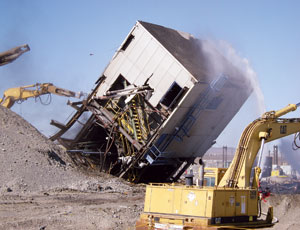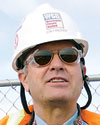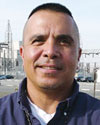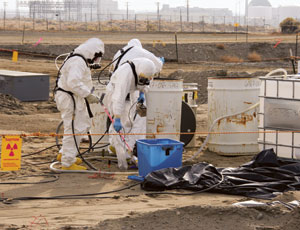Tri-City Herald reporter Annette Cary, who covers the U.S. Energy Dept.’s Hanford nuclear waste cleanup site for the Washington state newspaper, says employees there chafe at how high profile their work has become. For more than 60 years, their predecessors on the remote 586-sq-mile site toiled in total secrecy on a previous mission�to build America’s first generation of atomic weapons.

The legacy of Hanford’s massive industrial production has only recently become clear, as a new generation of scientists, engineers, technicians and construction workers confronts its by�product: the $2-billion-a-year remediation of some of the nastiest chemical and radiological hazards above and below ground.
The work is complex, physically demanding, uncertain and no longer secret. Deadlines and scrutiny abound at the site, as regulators and activists push cleanup speed and safety to avoid further ecological damage, particularly to the adjacent Columbia River, eastern Washington’s key economic and aesthetic asset.
Close to 20 tons of deadly plutonium once critical to bomb-making remain on-site. While the material is slowly and secretly being moved to DOE’s Savannah River Site in Aiken, S.C., its presence still mandates numerous roadway checkpoints staffed by machine-gun-toting private security guards.
Even the most modern tools and protective technologies don’t ease outdoor work in Hanford’s arid high-desert climate, which is capable of delivering below-zero winter days, triple-digit summer temperatures and windswept sandstorms that sorely test worker endurance and project schedules. Work is further confounded by other constraints: rising project costs, skill shortages and budget uncertainties in an economic downturn, with an incoming administration whose level of support for the cleanup mission remains unclear.
Added to the mix is the site’s employment fluctuations, faced by routinely shifting Hanford contractors who must inherit a fixed and unionized site workforce and by workers who must adapt to new corporate cultures and layoff risks each time DOE rearranges their employers. Carl Van Katwyk, a site manager and structural engineer working for site contractor CH2M Hill Cos. since Oct. 1, says the transition is his fifth since 1986. “The first is always the most unsettling, but it’s the way business is done here,” he says.
For now, the cleanup mission employs an army of 8,500 government and contractor personnel. Several hundred others support unrelated ventures on the Hanford footprint. “There are good reasons to work there,” says Cary. “It has a reputation for paying well, and there are certainly are a lot of interesting problems to solve.”
While still large, today’s Hanford workforce is a far cry from when World War II and the Cold War demanded many thousands of workers to build and operate the nation’s first and largest nuclear-weapon factory complex, located in a bucolic fishing and farming region.
Settlers, as well as Native Americans on the site for thousands of years, were evicted in the 1940s to make room for 50,000-plus construction workers recruited by the U.S. Army to quietly build nine full-scale production reactors along the river and hundreds of other structures in which highly toxic weapon materials were tested and manufactured. Safety concerns were secondary to America’s defense priorities at the time. Workers didn’t always understand the rationale or risks of their work, but jobs were plum and are still legacies today in some local families.
For decades, waste disposal was haphazard and considered temporary, with few records remaining or ever kept. At one of Hanford’s earliest documented waste burial grounds, notes on contents that included “pyrophoric uranium chips were written on little telephone notepads,” says Jon Fancher, field remediation manager for Washington Closure Hanford, the joint venture cleaning up some 1,700 waste sites and deconstructing 1,300 structures, of which 500 are highly contaminated. Even now, “anomaly teams” of engineers and industrial hygienists are often dispatched to investigate nasty surprises that turn up, he adds.

One of the biggest challenges was 450 million gallons of contaminated water discharged into groundwater over an 80-sq-mile area and 53 million gallons of high-level radioactive waste still stored in 177 aging underground tanks; 67 tanks are known to have leaked contents. Some 2,300 tons of spent uranium fuel rods also remain on site along the river, representing 80% of the entire DOE supply, including material from its other closed weapon sites nationwide.
The enormity of Hanford’s environmental nightmare wasn’t even discovered until the 1970s. It took until 1989 to develop an environmental enforcement framework, the federal-state Tri-Party Agreement, which sets cleanup deadlines with which DOE and its contractors have struggled to comply ever since. Even as some milestones slip, Matt McCormick, DOE assistant manager for central Hanford, ticks off some of the site’s latest cleanup success statistics: 95% of riverfront radioactivity removed; 432 site structures cleaned out and demolished and 3.6 billion gallons of contaminated groundwater treated. DOE is making a big push to detect groundwater contaminant plumes close to the Columbia River and recently expanded its aquifer sampling program to detect strontium, uranium and now chromium, once added to reactor cooling water as a corrosion inhibitor, says McCormick. “It’s a big problem,” he says.
The reactors themselves are getting a new look, with five of the nine original structures now in a “cocooned” state, partly demolished to their cores and contained to allow radioactivity to safely decay over the next 75 years while DOE develops a disposal scheme. McCormick says, however, the Umatilla, Yakima and Nez Perce tribes with river fishing rights want the reactors to remain “to remind people of what was there.” DOE also plans to fully open to the public Hanford’s historic “B” reactor, the world’s first full-scale plutonium-producing facility that dates to 1944. In August, it was declared a national historic landmark.
Other Hanford clean�up projects are not so easily fixed, such as the 177 underground tanks. Old industrial sludge and salt cake, which contain half of the total radioactivity within all of the tanks, are in 149 less secure single-shell tanks built before 1964, says Dennis J. Washenfelder, tank integrity and process engineering manager for Washington River Protection Solutions (WRPS), the site contractor that took over managing tank cleanup on Oct. 1.
The old tanks lack corrosion resistance. What remains in them are mineralized “chunks” of hydrated metal oxides that defy retrieval, Washenfelder says. Tank access for robotic equipment is only through narrow and corroded 12-in.-dia risers. “It’s like eating grapes with boxing gloves,” says Roger Bauer, a DOE tank cleanup manager. “Tanks are of a standard design, but each is unique.” Several “burping” tanks also emit potentially explosive hydrogen gas.

In DOE’s latest reshuffling of contractors tank farm cleanup management changed hands from CH2M Hill to WRPS, a URS Corp.-led joint venture. Single-shell tank retrievals will restart in January, although site officials acknowledge that the original deadline to empty all of them by 2018 could slip by up to 20 years. Tank contents will be vitrified at the site’s new plant, now scheduled for construction completion by 2019.
A late October afternoon visit to the “C” tank farm cleanup site, although not yet in full operation, requires dressing in a full containment suit and a short health and safety briefing by Stephanie Livesay, WRPS “radcon” first-line manager. Some briefings last 45 minutes, she says. In “vapor zones,” site workers must carry a 28-lb oxygen container. Work conditions can be taxing. To avoid 105� daytime temperatures, crews fitted with protective clothing last summer worked within a containment tent after dark for eight weeks to install retrieval equipment on just one tank, says Ken J. Anderson, a WRPS operations engineer. Air-conditioning is forbidden because it could potentially spread contamination. “Even 25 years ago, there was no protection. Everything just went into the air,” he says.
Today, it takes a 15-person crew of technicians, operations engineers, industrial hygienists and radiation-control managers to venture onto a tank cleanup jobsite, says Ken Jones, a site hygienist. Officials now are preparing for sludge retrievals using remote sluicing pumps and are practicing techniques in a “cold test” facility that simulates tank conditions, says Washenfelder.
Farther up the site, in the central “plateau” area where more tainted sludge remains in spent fuel basins, CH2M Hill Plateau Remediation Co. (CHPRC) is embarking on a new management challenge: The highly radioactive remaining waste contains PCBs, with abrasive particles that damage pumps, and materials with high uranium content that emit smoke when handled, says Mike Johnson, CHPRC sludge treatment manager. Mike Swartz, a deputy CHPRC project manager, is a veteran of another company-managed cleanup at DOE’s former Rocky Flats site, near Denver. He had once been a plutonium machinist there. Swartz is now helping manage decomissioning and cleanup of the “K” reactor sites and spent-fuel basins. “The engineering and craftsmanship of the water intake systems was amazing for the 1940s,” he says.
Elsewhere in the firm’s new purview is excavation of a 3,000-drum burial ground that is probed using GPS technology, says Wayne Moore, CHPRC operations support manager. Onsite since 1992, he now is working for his sixth contractor. “I’d like to be considered steward of a facility, not a contractor out to make money,” he says. But Moore acknowledges that changing cleanup priorities may limit funding for his work next year. Washington Hanford Closure’s building demolition mission is ahead of schedule, with 840,000 sq ft taken down in the site’s former fuel fabrication area, says Kim Koegler, a project engineer. “Uranium was brought here and made into fuel rods,” he says. One building yet to be demolished has 40,000 curies of radioactivity in it, Koegler says. The company also is tasked with deconstructing Hanford’s larger and more complex “N” reactor. Demolition of its water intake system has riled local tribes, who fear contaminated concrete may fall in the river. Work will involve only structures “above the high-water mark,” says Koegler.
Elsewhere, earthmoving equipment has been customized to prepare new space at the Environmental Restoration Disposal Facility, a huge lined landfill for low-level waste. Each of its eight cells will hold 2.8 million tons, says Jeff Armatrout, operations manager for Washington Hanford Closure. Worn-out heavy equipment is buried onsite because of contamination levels, he adds.
Some of Hanford’s most skilled workers are in the 222-S laboratory, where waste samples, mostly from the tank farms, are analyzed remotely in heavy steel- and glass-reinforced “hot cell” glove boxes with mechanical arms. “The sample is so radioactive it actually colors the glass jar it’s in,” says Don Hardy, a facility manager. Lab analysts, who often redesign manipulation equipment themselves, have to be experts. “It costs $1 million to pull a core sample out of a tank, and we can’t waste it,” he says.


Post a comment to this article
Report Abusive Comment